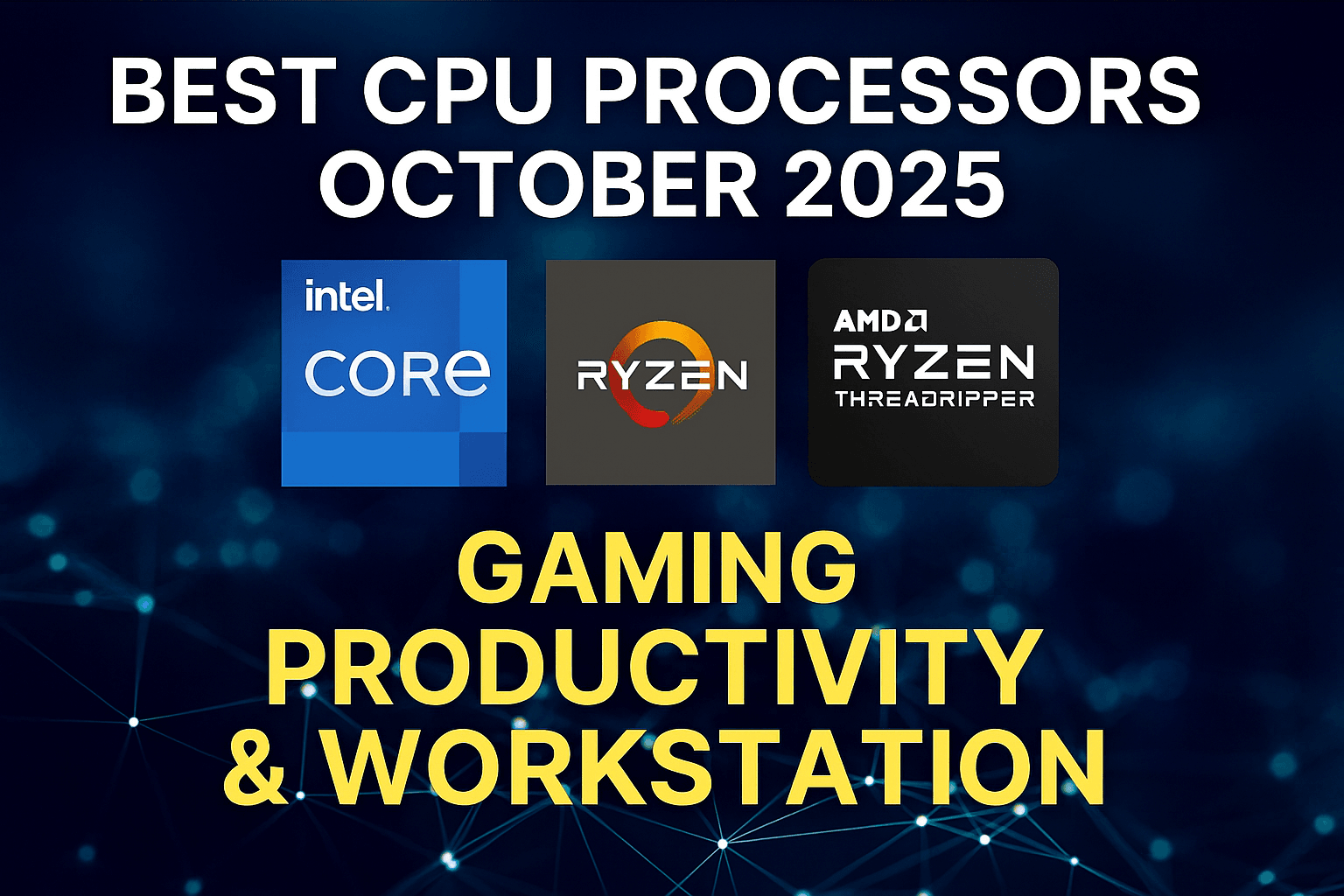October 2025 marks a decisive shift in the CPU market. AMD dominates gaming, productivity, and workstation segments with performance leads ranging from 23% to 145%, while Intel's Arrow Lake launch disappoints and the LGA1700 platform reaches end-of-life with no upgrade path beyond 14th gen.
The AMD Ryzen 7 9800X3D delivers a staggering 35% gaming advantage over Intel's Core Ultra 9 285K, while the Ryzen 9 9950X offers 23% better productivity performance with 83W less power consumption than Intel's i9-14900K. AMD's platform longevity through 2027+ creates long-term value that Intel's dead-end LGA1700 cannot match.
CPU Comparison Table
| Processor | Price | Cores/Threads | TDP | Best For | Key Strengths | Buy |
|---|---|---|---|---|---|---|
| AMD Ryzen 7 9800X3D | $480 | 8C/16T | ~120W | Gaming | 35% gaming lead, cool operation | Buy here |
| AMD Ryzen 9 9950X3D | $699 | 16C/32T | ~170W | Hybrid Gaming/Productivity | Matches 9800X3D gaming + productivity | Buy here |
| AMD Ryzen 9 9950X | $550 | 16C/32T | 170W | Productivity | 23% faster productivity, 83W less power | Buy here |
| AMD Ryzen 5 7600X | $219 | 6C/12T | 105W | Budget Gaming | AM5 upgrade path, efficiency | Buy here |
| Intel Core i5-14600K | $229 | 14C (6P+8E) | 180W | Budget Mixed Workloads | 49.5% faster multithread vs 7600X | Buy here |
| AMD Threadripper 9980X | Professional | 64C/128T | High | Workstation | 108% faster than Intel Xeon | Buy here |
Best Gaming CPU: AMD Ryzen 7 9800X3D
The AMD Ryzen 7 9800X3D is the undisputed gaming champion with a 35% performance lead over Intel's flagship Core Ultra 9 285K and 30% over the Core i9-14900K. At $480, it delivers exceptional value with much lower power consumption (~120W vs Intel's 250W+) and cooler operation requiring only a $40-60 tower cooler.
The AM5 platform provides crucial long-term value with support through 2027+, allowing multiple future CPU upgrades without motherboard replacement. For competitive gamers, high refresh rate enthusiasts (144Hz+), and VR gaming, the 9800X3D represents the clear choice.
Best Hybrid CPU: AMD Ryzen 9 9950X3D
For users needing both gaming and productivity, the Ryzen 9 9950X3D ($699) combines top-tier gaming performance with 16 cores for professional workloads. It matches the 9800X3D in gaming while beating Intel's i9-14900K in content creation, making it ideal for streamers, video editors, 3D artists, and software developers who game.
Best Productivity CPU: AMD Ryzen 9 9950X
The Ryzen 9 9950X ($550) dominates productivity with 23% faster multithreaded performance than Intel's i9-14900K, 27% advantage in AVX-512 workloads, and 8% faster Adobe Photoshop processing. The 170W TDP versus Intel's 253W means 83W less power consumption—approximately $30-50 annually in electricity savings for heavy workstation use.
For video editors, 3D artists, software developers, and data scientists, the 9950X delivers professional performance with superior efficiency and the long-term upgrade flexibility of the AM5 platform.
Best Budget Gaming: AMD Ryzen 5 7600X
At $219, the Ryzen 5 7600X delivers outstanding gaming performance competitive with far more expensive CPUs. While Intel's i5-14600K offers 7.6% better gaming and 49.5% faster multi-core performance at $229, the 7600X's 10-20% lower power consumption (105W vs 180W) and AM5 upgrade path through 2027+ make it the better long-term value for pure gaming builds.
The AM5 platform allows upgrading to future Zen 5+ or Zen 6 processors without motherboard replacement—flexibility Intel's dead-end LGA1700 cannot offer.
Best Budget Mixed Workloads: Intel Core i5-14600K
For users who game and stream or create content, the Intel i5-14600K ($229) provides excellent value with 14 cores (6P + 8E) delivering 49.5% faster multithreaded performance than the Ryzen 5 7600X. The extra cores handle encoding and background tasks effectively while maintaining strong gaming performance.
However, the 180W TDP requires better cooling ($50-80), and the LGA1700 platform's end-of-life status means no upgrade path beyond 14th gen—acceptable only for one-and-done builds lasting 4-5 years without CPU upgrades.
Best Workstation: AMD Threadripper 9980X
Professional workstations see AMD's most dominant performance. The Threadripper 9980X (64 cores, 128 threads) delivers up to 108% faster performance than Intel's Xeon W9-3595X—92% faster in Autodesk Maya, 83% faster in Cinebench, and 80% faster in Adobe After Effects. For 3D rendering, video editing, scientific computing, and professional applications, Threadripper provides unmatched performance.
Intel's Market Position
Intel's Arrow Lake (Core Ultra 9 285K) represents an unprecedented performance regression—actually slower than the previous-generation i9-14900K in gaming. At $629, it offers poor value and is not recommended. The previous-gen i9-14900K at $450 provides better performance and value for users accepting the LGA1700 platform's dead-end limitations.
The LGA1700 platform reaches end-of-life with no future CPU support beyond 14th gen. Intel's next-generation processors use the new LGA1851 socket, making any LGA1700 purchase suitable only for one-and-done builds with no upgrade expectations.
Platform Comparison: AM5 vs LGA1700
AMD AM5: Launched 2022, supports Ryzen 7000 and 9000 series with confirmed support through 2027+ for Zen 5+ and Zen 6 architectures. This provides 3-4 CPU generations on a single motherboard—exceptional long-term value. B650 motherboards ($120-180) offer the best entry point with full upgrade flexibility.
Intel LGA1700: Launched 2021, supports 12th, 13th, and 14th gen only—being replaced by LGA1851 for Arrow Lake and future processors. No upgrade path beyond 14th gen makes it a dead-end platform suitable only for users who won't upgrade CPUs for 4-5 years.
Upgrade Path Example: Purchase a B650 motherboard ($150) with Ryzen 5 7600X ($219) now, upgrade to high-end Zen 6 processor in 2027 without motherboard replacement. Total motherboard investment: $150 for three CPU generations spanning 5+ years versus Intel requiring complete platform replacement.
Buying Guide Summary
| Processor | Price | Choose For | Platform Notes |
|---|---|---|---|
| AMD Ryzen 7 9800X3D | $480 | Pure gaming, competitive esports, high refresh rate gaming, VR enthusiasts | AM5 platform, 2027+ upgrade support |
| AMD Ryzen 9 9950X3D | $699 | Gaming + professional content creation, streamers, video editors who game, dual-purpose builds | AM5 platform, 2027+ upgrade support |
| AMD Ryzen 9 9950X | $550 | Productivity-focused workstations, video editing, 3D rendering, software development, data analysis | AM5 platform, 30-50% lower power than Intel |
| AMD Ryzen 5 7600X | $219 | Budget gaming builds, efficiency-focused systems, long-term upgrade path priority | AM5 platform, 10-20% lower power consumption |
| Intel Core i5-14600K | $229 | Budget gaming + streaming/content creation, heavy multitasking, one-and-done builds only | LGA1700 end-of-life, no upgrade path |
| AMD Threadripper 9980X | Professional | Professional 3D rendering, video production, scientific computing, mission-critical workstation applications | Workstation platform, 108% faster than Intel Xeon |
Platform Decision: Choose AM5 for long-term builds with upgrade flexibility (2027+ support). Choose LGA1700 only for one-and-done budget builds with no upgrade plans—accept the dead-end platform reality.
Power Efficiency: AMD processors consume 30-50% less power than Intel equivalents, translating to lower electricity costs, quieter cooling, and reduced system heat over the system's lifetime.
Conclusion
October 2025's CPU market shows clear AMD dominance across all segments. The Ryzen 7 9800X3D's 35% gaming lead, Ryzen 9 9950X's productivity advantages, and Threadripper's workstation supremacy establish AMD as the performance leader. Combined with the AM5 platform's support through 2027+ and superior power efficiency, AMD represents the smart choice for most builders.
Intel remains viable only for specific scenarios: budget mixed workloads with the i5-14600K or value-conscious users finding deals on the price-reduced i9-14900K who accept platform end-of-life limitations. Intel's Arrow Lake disappointment and LGA1700's dead-end status create a challenging market position that will likely require multiple product cycles to resolve.
For new builds in October 2025, AMD offers superior performance, efficiency, and long-term platform value backed by comprehensive benchmark data and expert consensus.






